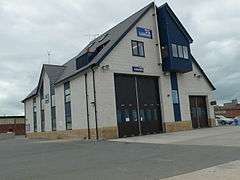Rhyl Lifeboat Station
Rhyl Lifeboat Station is located in the North Wales town of Rhyl. For over 150 years, the Lifeboat Crew in Rhyl have been saving lives at sea. The first lifeboat was stationed in the town in 1853 and the present station was opened in December 2001. The station operates a Mersey-class all-weather boat (ALB) and an IB1 inshore lifeboat (ILB).
| Rhyl Lifeboat Station | |
|---|---|
 The Boathouse of Rhyl Lifeboat Station | |
 Rhyl, Denbighshire | |
| General information | |
| Type | RNLI Lifeboat Station |
| Location | Marine Parade, Rhyl, UK |
| Country | Wales, UK |
| Coordinates | 53°19′56″N 003°29′36″W |
| Opened | 1853 |
| Owner | Royal National Lifeboat Institution |
History
In 1852, the Shipwrecked Fishermen and Mariner’s Society placed a lifeboat at Rhyl. Shortly after, in 1853, the lifeboat "Gwylan y Mor", capsized with the loss of six of her crew.[1]
In 1963, Rhyl Lifeboat (Anthony Robert Marshall) was launched on service to the first lifeboat rescue of a hovercraft.[2] For this service, a silver medal for gallantry was awarded to Coxswain Harold Campini.
In 1967, the first D Class ILB Lifeboat was put on service in Rhyl to accompany the All-Weather Lifeboat for inshore rescues.
In 1973, the bronze medal for gallantry was awarded to Helmsman Don Archer-Jones for the courage and seamanship he displayed when the ILB rescued 2 boys cut off by the tide, and clinging to a perch marking the sewer outfall between Rhyl and Prestatyn, in a gale force westerly wind and a rough sea on 7 August. Crew member Paul Frost was awarded a medal service certificate.
In 2002, The Duke of Kent, presented the lifeboat station with an anniversary Vellum to celebrate the 150th anniversary of Rhyl lifeboat.
Description
The lifeboat station is built on the promenade in Rhyl. The building contains the All-Weather Lifeboat, Inshore Lifeboat, Talus tractor, and Softrac used for Search and Rescue operations off the coast in Rhyl. The station also has a short concrete slipway that leads down to the beach. Each boat is kept on a carriage attached to a tractor which propels it down to the water and brings it back after use. A fund-raising shop is situated on the west side of the boathouse.
Area of operation
The Mersey-class All-Weather lifeboat at Rhyl has a top speed of 17 knots (31 km/h). The lifeboat covers from Llanddulas (west) to Mostyn (east). North of the station the All-Weather lifeboat covers the Oil and Gas platforms of the Douglas and Hamilton fields, and also the windfarms of North Hoyle; Rhyl Flats; and the Gwynt-Y-Mor fields. Rhyl Lifeboat is a part of the contingency plan for any evacuation of the rigs. The area also covers the outer approaches to Liverpool. Adjacent ALBs are at Llandudno Lifeboat Station to the west, and Hoylake to the east. There is also an ILB at Flint to the east.
Fleet
All Weather Boats
| Dates in service | Class | ON | Op. No. | Name |
|---|---|---|---|---|
| 1852–1856 | Gwylan-y-Mor | |||
| 1856–1893 | Tubular-type | Morgan | ||
| 1878–1888 | Self-Righter | Jane Dalton | ||
| 1888–1899 | Self-Righter | ON 166 | Jane Martin | |
| 1893–1897 | Tubular-type | ON 287 | Caroline Richardson | |
| 1939–1949 | Surf-class | ON 835 | Gordon Warren | |
| 1949–1968 | Liverpool-class | ON 869 | Anthony Robert Marshall | |
| 1968–1990 | Oakley-class | ON 993 | 37-22 | Har Lil |
| 1990–1992 | Rother-class | ON 1000 | 37-29 | Mary Gabriel |
| 1992–present | Mersey-class | ON 1183 | 12-24 | Lil Cunningham |
Inshore Lifeboats
| Dates in service | Class | Op. No. | Name |
|---|---|---|---|
| 1967–1975 | D-class (RFD PB16) | D-141 | unnamed |
| 1976–1987 | D-class (Zodiac III) | D-243 | unnamed |
| 1987–1995 | D-class (EA16) | D-348 | Banks' Staff I |
| 1995–2004 | D-class (EA16) | D-485 | Stafford with Rugeley |
| 2004–2014 | D-class (IB1) | D-632 | Godfrey and Desmond Nall |
| 2014–present | D-class (IB1) | D-770 | Mary Maxwell |
Notable Rescues
- 1962 - ALB, First service ever made by a lifeboat to a hovercraft [3]
- 1973 - ILB, Rescue to children stuck on sewer outfall [4]
- 1990 - Towyn and Pensarn floods [5]
- 2011 - ALB, Rescue kayaker with hypothermia [6]
- 2011 - ILB, Rescue to mother and son with hypothermia [7]
- 2012 - ALB, Rescue to cargo ship in Llanddulas [8]
See also
References
- A Melancholy Catastrophe 1853
- The World's first rescue by Lifeboat of a hovercraft
- Rhyl History
- 1973 - Rhyl - Don Archer-Jones
- Towyn floods remembered: 20 years on
- Kayaker rescued five hours after paddling out to windfarm
- Rhyl RNLI volunteers rescue mother and son with hypothermia
- Oil leaks from Carrier off Llanddulas after crew saved